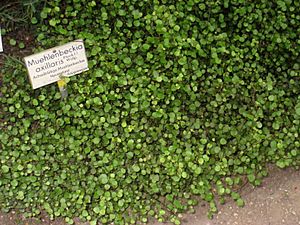Muehlenbeckia axillaris facts for kids
Quick facts for kids Muehlenbeckia axillaris |
|
|---|---|
 |
|
| Scientific classification | |
| Genus: |
Muehlenbeckia
|
| Species: |
axillaris
|
The Muehlenbeckia axillaris is a cool plant often called the creeping wire vine or sprawling wirevine. It's a small, evergreen shrub that spreads out like a mat, growing up to about 1 metre (3 ft 3 in) wide. You can find it naturally in New Zealand and parts of Australia, like Tasmania, New South Wales, and Victoria.
This plant has thin, reddish-brown stems. Its leaves are shiny and tiny, usually less than 1 cm (0.39 in) across. They are also quite thin, only about 2–4 mm (0.079–0.157 in) thick. The flowers are small and not very noticeable. They are yellowish-white and grow in groups of up to three. Later, in late summer or fall, the plant produces small, shiny black fruits. These fruits can be up to 3.5 mm (0.14 in) long.
The creeping wire vine is a very tough plant. It can handle dry weather and grows quickly. It also does well in many different light conditions. People often grow it as a ground cover because it spreads out nicely. It can grow in rocky places or regular garden soil. Even though it grows fastest when it's warm, it can also survive freezing weather.
Contents
Understanding Muehlenbeckia axillaris
This section helps you learn more about the creeping wire vine. We will look at its features and how it grows.
What Does it Look Like?
The creeping wire vine is a low shrub. It forms wide, wiry mats on the ground. These mats can spread out to be about 1 metre (3 ft 3 in) across. Its stems are thin and have a reddish-brown color.
The leaves are small and glossy. They can be squarish or roundish in shape. Each leaf is usually less than 1 cm (0.39 in) wide. They are also quite thin, about 2–4 mm (0.079–0.157 in) thick.
Flowers and Fruit
The flowers of the creeping wire vine are not very showy. They are small and yellowish-white. Each flower is only about 4–8 mm (0.16–0.31 in) wide. They grow in small groups of up to three flowers. You will find them in the leaf axils, which are the spots where leaves join the stem.
After the flowers, the plant produces fruit. The fruit is black and shiny. It can grow up to 3.5 mm (0.14 in) long. These fruits usually appear in late summer and fall.
Where Does it Grow?
This plant is native to a few places. It grows naturally in New Zealand. You can also find it in several parts of Australia. These include the states of Tasmania, New South Wales, and Victoria.
How Does it Grow?
The creeping wire vine is known for being very hardy. This means it is tough and can survive in different conditions. It is also drought-tolerant, so it doesn't need a lot of water. It grows quickly, which makes it a good choice for covering ground.
It can grow well in many light conditions. This plant is often used as a ground cover in gardens. It can even grow in rocky areas. It also does well in regular potting soil. While it grows fastest in warm weather, it can handle freezing temperatures.
How Scientists Named This Plant
The way plants and animals get their scientific names is called taxonomy. It helps scientists organize living things.
The First Description
The Muehlenbeckia axillaris was first described in 1847. A famous botanist named Joseph Dalton Hooker gave it its first scientific name. He called it "Polygonum (Muhlenbeckia) axillaris".
Later, two other scientists changed its name slightly. Stephan Endlicher in 1848 and Wilhelm Gerhard Walpers in 1849 both referred to it as simply Muehlenbeckia axillaris. This is the name we use today.

